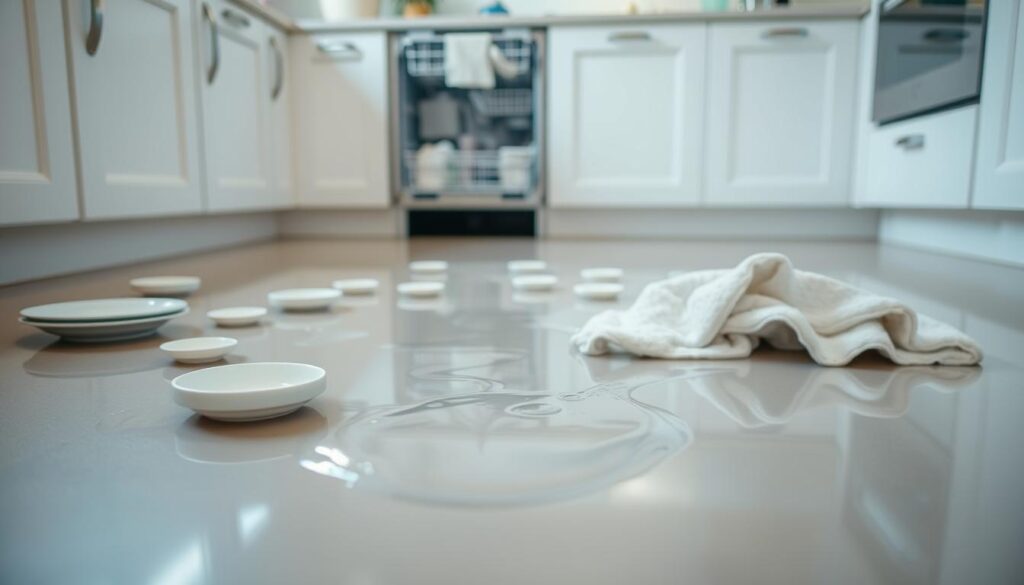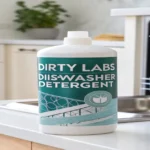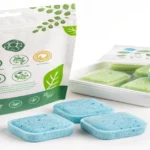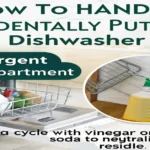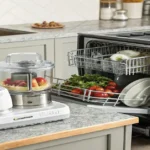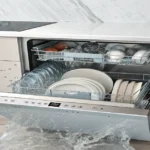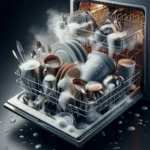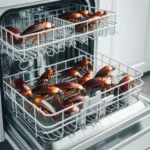When your dishwasher floods, it’s a big hassle. But, you can fix it fast with the right steps. This article will guide you through fixing a flooded dishwasher.
You’ll learn about common problems and how to drain and unclog your dishwasher.
Key Takeaways
- Determine the root cause of the dishwasher flooding, such as a clogged drain hose or faulty drain pump.
- Take safety precautions and gather the necessary tools to safely drain the water from the dishwasher.
- Clean the dishwasher’s drain hose and filter to remove any blockages and restore proper drainage.
- Check and, if necessary, replace a faulty drain pump to prevent future dishwasher flooding.
- Address any issues with the float switch to ensure the dishwasher can properly detect and respond to water levels.
Understanding the Causes of a Flooded Dishwasher
When your dishwasher floods, finding the cause is key. Common problems include a clogged drain hose or filter, or issues with the drain pump or float switch.
Clogged Drain Hose or Filter
A clogged drain hose or dishwasher filter often causes flooding. Food, grease, and debris can block water flow. This leads to water backing up and flooding the dishwasher.
Faulty Drain Pump or Float Switch
A malfunctioning drain pump or float switch can also flood your dishwasher. The pump removes dirty water, and the float switch controls the pump’s operation. If these fail, water won’t drain properly, causing flooding.
Knowing the cause of the problem is the first step to fixing a flooded dishwasher. Understanding these issues helps you prepare for repairs. It ensures your dishwasher drains well and prevents water buildup.

Preparing for the Repair Process
Before you start fixing a flooded dishwasher, it’s key to take safety steps and gather the right tools. This preparation makes the repair smoother and safer. It also increases the chances of fixing the problem successfully.
Safety Precautions
First, make sure you’re safe when dealing with a flooded dishwasher. Turn off the dishwasher’s power at the circuit breaker or unplug it. This step prevents electrical shock during the repair.
Wear gloves and eye protection to protect your hands and eyes from water and debris. Having towels ready helps soak up water and keeps the area dry.
Gathering Necessary Tools and Supplies
- Baking soda and vinegar: These household items can help clean and deodorize the affected areas.
- Towels: Absorbent towels are essential for mopping up water and keeping the work area dry.
- Drain hose and filter: Inspect these components for any clogs or damage that may have contributed to the flooding.
- Replacement parts: If the drain pump or float switch is faulty, you’ll need to have the appropriate replacement parts on hand.
By preparing well, you’re on the right track to fixing your flooded dishwasher safely and efficiently.
Step-by-Step Guide to Draining a Flooded Dishwasher
If your dishwasher is flooded, don’t worry. This guide will help you safely drain the water from it.
First, find out why the dishwasher is flooded. Look at the bottom of the dishwasher for water accumulation. If you see water standing there, it might be a clogged drain hose or a broken drain pump.
- Find the drain hose at the dishwasher’s back and remove it from the drain line.
- Put a bucket under the hose to catch the excess water as it drains.
- Use a baking soda and vinegar solution to clear the drain hose. Pour it in, wait a few minutes, then flush with hot water.
If draining the hose doesn’t fix the problem, the drain pump or float switch might be the issue. Check these parts to figure out what to do next.
By following these steps, you can drain your flooded dishwasher and avoid future drainage issues. Always be careful and seek help from a pro if you’re not sure about anything.
Unclogging the Drain Hose and Filter
If your dishwasher has trouble draining, it might be because of a clogged drain hose or a dirty dishwasher filter. Fixing these issues can fix the water flow problem and stop more drainage issues.
Inspecting the Drain Hose
First, check the dishwasher drain hose for any blockages or clogs. Take off the hose from the dishwasher’s back and look for debris or buildup. If you spot a clog, use a mix of baking soda and vinegar to clean it out.
Cleaning the Dishwasher Filter
Then, check the dishwasher filter inside the dishwasher. It can get clogged with food and other stuff, stopping water from draining. Take out the filter and clean it with a soft brush and warm water. Make sure it’s clear of any blockages before putting it back.
| Step | Action |
|---|---|
| 1 | Disconnect the dishwasher drain hose from the back of the appliance. |
| 2 | Inspect the hose for any clogs or debris. |
| 3 | Flush the hose with a mixture of baking soda and vinegar to help dissolve the blockage. |
| 4 | Remove the dishwasher filter and clean it thoroughly with a soft-bristled brush and warm water. |
| 5 | Reinstall the clean filter, ensuring it is properly secured. |
By fixing the drain hose and dishwasher filter, you can make sure the water drains right. This stops the dishwasher from having drainage issues and keeps it working well.
How to Fix a Flooded Dishwasher
If your dishwasher is flooded, don’t worry. You can fix it and make your kitchen clean again. First, find out why it’s flooding. It might be a clogged drain hose, a broken drain pump, or a problem with the float switch.
After finding the problem, start fixing it. Unplug the dishwasher and turn off the water supply. This keeps you safe while you work.
- Look at the drain hose and filter for blockages. Use a baking soda and vinegar mix to clean it. Then, rinse it with water to make sure it’s clear.
- If the hose and filter are okay, the issue might be with the drain pump. Check if it’s working right. If not, you’ll need to replace it.
- Check the float switch too. If it’s stuck or broken, water can build up in the dishwasher.
By following these steps, you can fix a flooded dishwasher quickly. Always be careful and ask a pro if you’re not sure about anything.
If you’re still having trouble with your Bosch dishwasher or any other dishwasher flooding issues, get help from a skilled repair technician. They can find the problem and fix it, so your kitchen works again.
Checking and Replacing the Drain Pump
If the drain hose and filter aren’t the issue, it’s time to check the drain pump and float switch. These parts are key to making sure your dishwasher drains right. They also stop water from building up inside the dishwasher.
Testing the Drain Pump
To start, test if the drain pump works. Here’s how:
- Find the drain pump, usually at the dishwasher’s bottom.
- Turn off the dishwasher’s power and remove panels to get to the pump.
- Use a multimeter on the ohms setting to check the pump’s continuity. If there’s no continuity, the pump is bad and needs a new one.
Replacing a Faulty Drain Pump
If the drain pump is faulty, it’s time for a new one. Here’s how to do it:
- Turn off the power and water to the dishwasher.
- Take out the old pump by unscrewing it and disconnecting the wires.
- Put in the new pump, making sure it’s right and securely attached.
- Turn the power and water back on, then test the new pump to make sure it works.
If you’re not sure about fixing it or have doubts, it’s smart to get professional help. They can also help with warranties and email support.
Dealing with a Stuck Float Switch
If the float switch in your dishwasher gets stuck, it can cause big problems. It’s key for controlling water levels. When it breaks, the dishwasher drain won’t work right.
A stuck float switch often happens because of a clogged dishwasher. Food, grease, and other stuff can block it. This stops the dishwasher from draining and can cause water leaks.
Think the float switch might be stuck? Check the dishwasher drain for blockages first. Try moving the float switch gently to see if it’s free.
At times, cleaning or resetting the float switch can fix the problem. But if it doesn’t work, you might need a new one. This job is best for a professional to do right.
Not sure what’s wrong or don’t want to fix it yourself? It’s smart to contact a professional. They can help fast and offer warranty and email support.
Conclusion
Fixing a flooded dishwasher isn’t hard. Knowing why it happens, like a clogged hose or a bad pump, helps. Taking safety steps makes it easier to fix and use your dishwasher again.
This article showed you how to drain and unclog your dishwasher. It also covered troubleshooting and replacing parts if needed. Always check the drain and make sure the water flows well. Preventing future floods is key.
With the right tools and effort, you can solve this problem. Don’t let a flooded dishwasher upset you. Follow these tips, and you’ll be using your dishwasher without worry soon.
FAQ
What causes a dishwasher to flood?
A flooded dishwasher can be caused by a few things. These include a clogged drain hose or filter. It could also be a faulty drain pump or float switch. Or, there might be problems with the drain valve or line.
How do I safely prepare to fix a flooded dishwasher?
First, make sure you’re safe before fixing a flooded dishwasher. Turn off the power and have towels ready. Also, get cleaning products like baking soda and vinegar.
How do I drain a flooded dishwasher?
To drain a flooded dishwasher, find where the water is coming from. Then, access the drain hose and pump. Use baking soda and vinegar to clear any blockages. Follow a step-by-step guide to safely remove the water.
How do I unclog the dishwasher’s drain hose and filter?
Check the drain hose for clogs or blockages. Clean the dishwasher filter well. A mix of baking soda and vinegar can help dissolve and flush out debris in the hose or filter.
What if the drain pump is the issue?
If the hose and filter aren’t the problem, check the drain pump. Test the pump’s functionality. If it’s faulty, replace it following the proper steps.
What do I do if the float switch is stuck?
A stuck float switch can also cause flooding. Try to move the float switch gently up and down. If it’s still stuck, you might need a professional repair.

I’m Ian Welkins, a seasoned professional in the kitchen industry. My passion now drives me to provide invaluable insights into the world of top-notch kitchen products. With years of hands-on experience, I’m your go-to source for culinary excellence.
